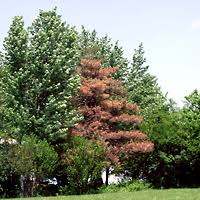Pine Wilt Tree Disease Found in Ponca City
Mike Seals - July 2, 2020 11:24 am

Pine Wilt Disease in Ponca City
The City of Ponca City Parks and Recreation Department manages over 730 acres of park and passive land and in so doing also manages the urban forest on those lands. Over the last year, staff has noticed an increase in deaths among non-native pine trees, specifically Austrian, Scotch and Japanese black pines. After investigating these deaths and speaking with the Oklahoma Forestry Department, staff has concluded that the trees died from Pine Wilt Disease. The Parks and Recreation Department has communicated these findings to local tree trimming companies and is asking citizens to be diligent in looking at their pine trees.
According to the Oklahoma State University’s Oklahoma Cooperative Extension Service Fact Sheet. “Pine Wilt is a devastating tree disease affecting many non-native pines in Oklahoma, particularly in residential areas through the I-35 corridor and eastward. The disease can kill trees in as little as three weeks. In the Midwest, the most commonly killed trees are Scotch and Austrian pines, both of which are highly susceptible to Pine Wilt,” The Pine Wilt fact sheet continues stating:
In most cases, trees that develop Pine Wilt are more than ten years old. Typically, symptoms appear in July and may develop through December. The needles on a few branches will initially fade to green-gray and wilt. Needles remain attached and resin flow is reduced, resulting in the wilt symptom. The disease spreads rapidly inside the tree and within a few weeks, the entire tree may show symptoms of wilt and browning. In general, infected trees die quickly, often in a single growing season. It is not uncommon for infected trees to occur in close proximity to healthy trees. Dying or dead trees typically exhibit blue stain symptoms in the wood when cut.
Pine Wilt Disease is caused by a microscopic roundworm called the pinewood or pine wilt nematode. Pinewood nematodes have a unique relationship with long horned beetles known as pine sawyer beetles. Pinewood nematodes are microscopic and cannot move from tree to tree without assistance. These nematodes have developed an intimate relationship with pine sawyer beetles to facilitate movement among trees. As adult pine sawyer beetles emerge from wood colonized by pinewood nematodes, large numbers of nematodes have already moved into the beetles’ respiratory openings and are thus carried in the tracheal system. Beetles become vectors for the nematodes as they visit healthy trees to feed on bark, thereby introducing nematodes into the tree through feeding wounds. The beetles are most active from May through late September with disease symptoms usually appearing shortly thereafter from July through December.
The fact sheet recommends removal of infected trees and then burning the debris. However, open burning is not allowed within the city limits without special authorization. As such, citizens not using a local contractor to remove and dispose of Pine Wilt diseased and dead trees are encouraged to contact the Parks and Recreation Department, at 580.767.0430 to coordinate disposal at a City of Ponca City permitted drop off disposal site.
The full fact sheet/report can be found at:
http://pods.dasnr.okstate.edu/docushare/dsweb/Get/Document-9439/EPP-7674web.pdf.



